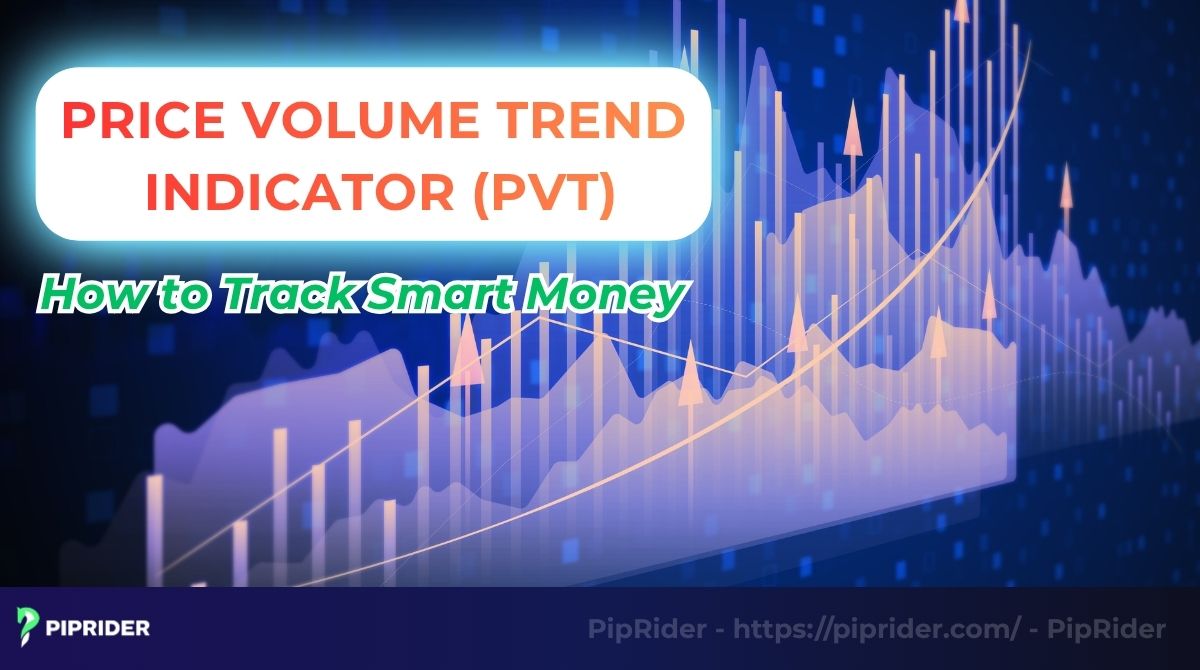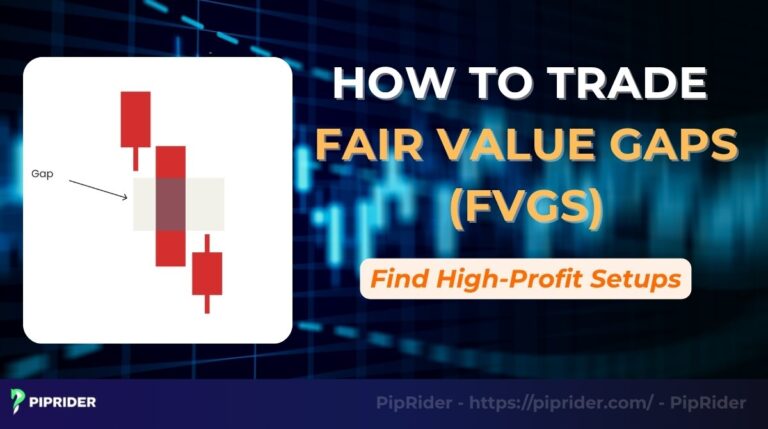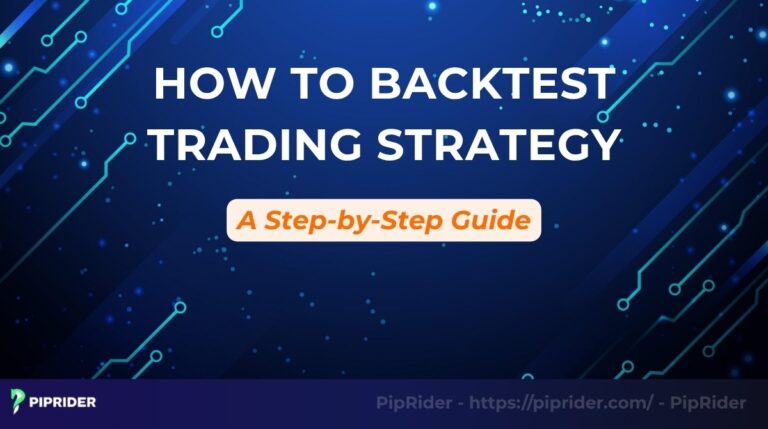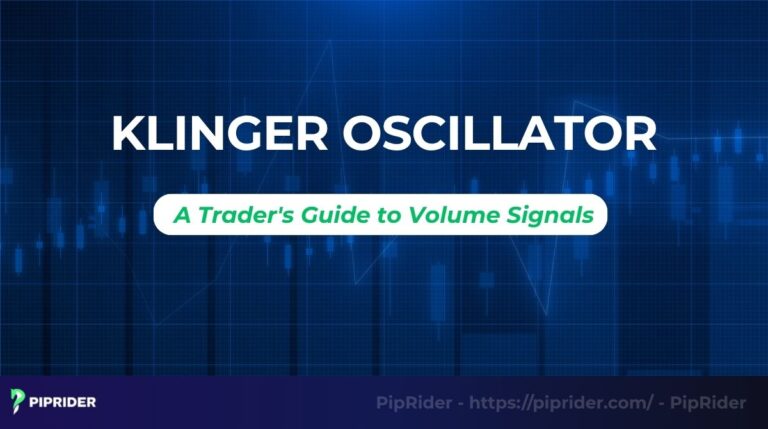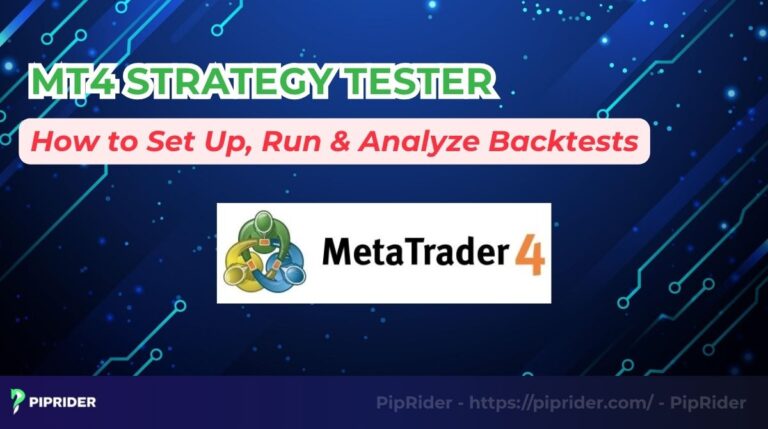Price action tells you what is happening, but volume reveals the conviction behind the move. The Price Volume Trend indicator (PVT) is a powerful tool designed to connect these two critical pieces of information. By integrating the percentage change in an asset’s price with its trading volume, the PVT offers a more nuanced look into money flow and trend strength than many other tools.
This comprehensive guide will break down everything from the formula to practical PVT trading strategies you can apply.
Key Takeaways
- The PVT is a momentum indicator that tracks cumulative volume, giving more weight to periods with significant price changes.
- Unlike On-Balance Volume, the Price Volume Trend considers the magnitude of price moves, offering potentially earlier and more sensitive signals.
- It is primarily used to confirm the strength of a trend and to spot potential reversals through bullish and bearish divergences.
- This indicator is most effective when used to confirm signals from other technical analysis tools like moving averages or the RSI.
- This guide focuses on interpreting and applying the volume trend indicator for real-world analysis and trading setups.
1. Understanding the Price Volume Trend Indicator

The Price Volume Trend (PVT) is a technical indicator that measures money flow by combining an asset’s price and volume into a single cumulative line (Commodity.com, n.d.).
PVT’s primary purpose is to aid in trend identification, gauge the strength of a trend, and confirm price movements. By weighting volume with the percentage of price change, it helps traders see if a trend is backed by real conviction from institutional players or “smart money.”
The price and volume trend indicator stands apart due to its unique methodology. Here’s a quick comparison to other common tools:
- vs. On-Balance Volume (OBV): The PVT is considered more sensitive. While OBV adds or subtracts the entire daily volume based only on direction, the PVT incorporates the magnitude of the price change, offering a more nuanced view of market conviction.
- vs. Money Flow Index (MFI): The MFI is a bounded oscillator, scaled from 0 to 100, used to identify overbought or oversold conditions. In contrast, the PVT is an unbounded, cumulative line focused purely on trend confirmation and money flow.
- vs. Accumulation/Distribution (A/D) Line: The PVT’s calculation is simpler, using only the percentage change from the previous close. The A/D Line uses a more complex formula involving the high, low, and close to measure intraday pressure.
2. How the Price Volume Trend Works
The logic of the Volume Price Trend is that not all trading activity carries equal weight. A 5% price surge backed by heavy trading shows far more conviction than a 0.5% nudge on the same share turnover. To capture this, the PVT multiplies a period’s traded shares by its percentage price change, measuring a trend’s true force as a reflection of supply and demand.
This mechanism makes the PVT an excellent tool for tracking the footprint of “smart money.” When price and the PVT rise together, it strongly confirms a healthy, institutionally backed trend. Conversely, if the price inches up while the indicator is flat or falling, it’s a red flag that the move lacks conviction and could easily fail.
3. Formula and Calculation of the PVT
The Price Volume Trend is a cumulative indicator, meaning its current value is always based on its previous value. The calculation adds a volume-weighted amount to the prior period’s total.
3.1. The Formula
PVT = Previous PVT + [((Current Close – Previous Close) / Previous Close) * Volume]
Where:
- Previous PVT: The value of the PVT from the prior period.
- Current Close: The closing price of the current period.
- Previous Close: The closing price of the prior period.
- Volume: The total volume traded during the current period.
The key part of this formula is that it multiplies the period’s volume by the percentage price change. This result is then added to (or subtracted from) the previous PVT value to create a continuous line.
3.2. Step-by-Step Calculation Example
To see how this works, let’s break it down with a simple two-day example for a stock.
- Previous PVT (starting value) = 200,000
- Previous Day’s Close = $50.00
- Current Day’s Close = $51.00
- Current Day’s Volume = 100,000 shares
Calculation Steps:
Step 1: Calculate the percentage price change
( ($51.00 – $50.00) / $50.00 ) = 0.02 (a +2% move)
Step 2: Apply the PVT formula
New PVT = 200,000 + (0.02 * 100,000) = 200,000 + 2,000 = 202,000
The PVT line moves up from 200,000 to 202,000, reflecting positive, volume-weighted money flow.
Comparison with OBV:
For the same data, the On-Balance Volume (OBV) calculation would simply add the entire volume since the price closed higher:
New OBV = Previous OBV + 100,000
This comparison highlights the PVT’s sensitivity. The PVT’s value increased by only 2,000 because the price move was relatively small (+2%). The OBV, however, registered a massive increase of 100,000. This shows how the PVT adjusts its reading based on the conviction behind the price move, not just its direction.
4. How to Interpret the Price Volume Trend
Interpreting the Price Volume Trend indicator is less about its absolute numerical value and more about its direction and its relationship with the price. There are three primary trading signals traders watch for to gain an edge.
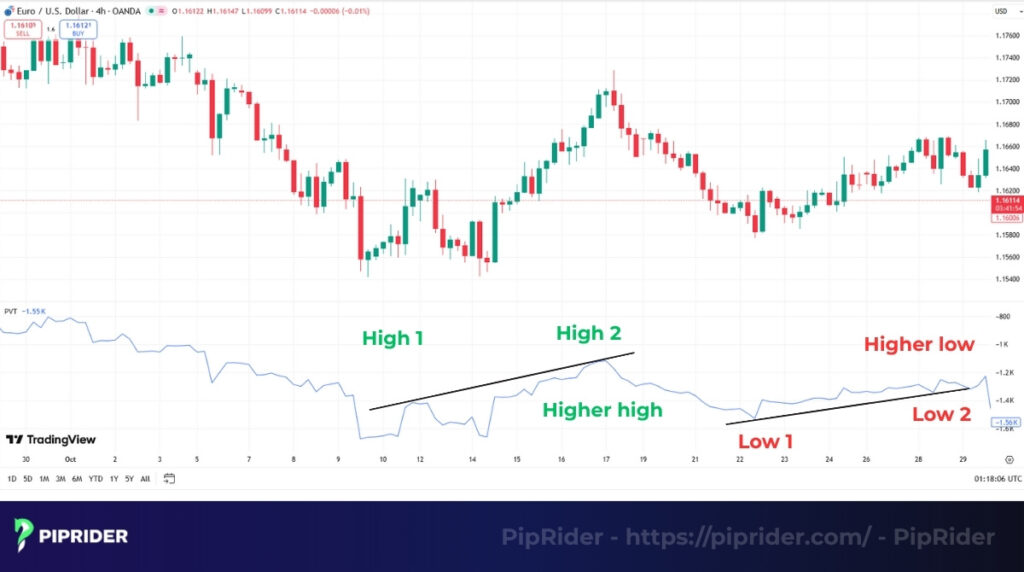
4.1. Identifying Trend Direction
The simplest interpretation is to follow the indicator’s slope as a proxy for money flow. A rising PVT line confirms an uptrend by showing positive, volume-weighted buying pressure, while a falling PVT line confirms a downtrend by indicating dominant selling pressure.
4.2. Divergences
Divergences offer powerful reversal signals when the PVT and price disagree.
- Bearish Divergence: This occurs if the price makes new highs while the indicator makes lower highs, signaling that buying conviction is fading and a downward reversal may be near.
- Bullish Divergence: This appears if the price hits new lows while the indicator forms higher lows, suggesting selling pressure is exhausted and an upward reversal is possible.
4.3. Volume Confirmation for Breakouts
The PVT is ideal for validating breakouts beyond key levels. A price move above resistance is far more credible if the indicator is also rising sharply, confirming the move is backed by significant buying pressure. Without a confirming rise in the PVT, a breakout is often a false signal or a “trap.”
5. PVT vs. OBV: What’s the Difference?
On the surface, the Price Volume Trend and the On-Balance Volume seem very similar. Both are cumulative volume indicators used to confirm trends and spot divergences. However, the core difference lies in their calculation, which makes the PVT a more sensitive and nuanced tool.
Here is a direct comparison of their key attributes:
| Factor | Price Volume Trend | On-Balance Volume |
| Calculation Method | Volume is weighted by the percentage of price change. | The entire period’s volume is added or subtracted based on the daily price direction. |
| Sensitivity | More sensitive to the magnitude of price moves. | Less sensitive; treats all moves equally, which can cause lag. |
| Best Use | Identifying the conviction behind short-term price swings. | Confirming long-term trends where direction matters more than magnitude. |
| Divergence Signals | Divergences can appear earlier and more clearly. | Broader movements can sometimes mask subtle, early divergences. |
In short, the PVT is the superior tool if you want to measure the conviction behind price moves, as it accounts for the strength of price change. The OBV is simpler and better suited for tracking the general, long-term flow of volume without the nuance of price volatility. Many traders prefer the PVT for its added layer of sensitivity.
6. How to Trade Using the PVT Indicator
While the PVT can provide valuable insights, it’s most effective when integrated into a structured trading plan. Below are three common strategies that leverage the PVT’s strengths for trend confirmation, reversal signals, and breakout filtering.
6.1. Strategy 1: Trend Confirmation

This is the most straightforward way to use the Price Volume Trend indicator. The goal is to ensure that the volume-weighted money flow supports the price action before entering a trade. This helps you trade with the dominant trend and avoid weak or choppy markets.
- Buy Signal: A trader looks for a clear uptrend on the price chart (e.g., higher highs and higher lows) and confirms it with a steadily rising PVT line. An entry is taken only when both are in agreement.
- Sell Signal: Conversely, a short (sell) trade is considered only when the price is in a clear downtrend and the PVT line is also falling, confirming that selling pressure is dominant.
6.2. Strategy 2: Divergence Reversal Setup
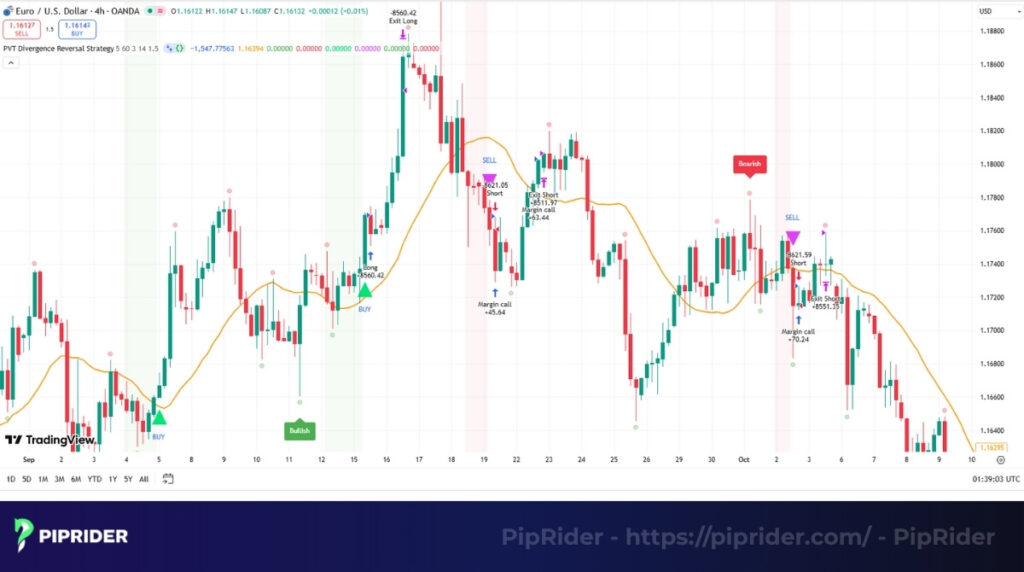
This strategy aims to catch trend reversals early by spotting divergences. It’s a more advanced technique that can lead to highly favorable risk/reward setups, but it requires patience and confirmation.
- Bullish Reversal: Look for a bullish divergence (price makes a new low, PVT makes a higher low). This is not an immediate buy signal. Instead, wait for the price to confirm the reversal (e.g., by breaking a downward trendline) before entering a long position.
- Bearish Reversal: Spot a bearish divergence (price makes a new high, PVT makes a lower high) and then wait for the price to show weakness (e.g., breaking below a key support level) before entering a short trade.
6.3. Strategy 3: Breakout Filter
False breakouts are a common problem for traders. The indicator can act as a powerful filter to distinguish between legitimate breakouts and fakeouts by confirming the presence of institutional volume.
When the price breaks above a key resistance level or trendline, an entry is only taken if the PVT is also rising strongly. This confirms that the breakout is backed by significant buying pressure. If the price breaks out but the PVT is flat or falling, the signal is ignored as a likely fakeout.
7. PVT in Different Market Conditions
A good indicator should adapt to the market’s current state. The Price Volume Trend’s behavior changes distinctly between trending and ranging conditions and offers valuable context-specific clues to a trader.
7.1. In a Trending Market
During a strong, healthy trend, the PVT should move in lockstep with the price. This is its primary function: to confirm that the trend has real momentum behind it, driven by significant, volume-weighted money flow.
For example, in a powerful uptrend, you should see both the price making higher highs and the PVT line also charting a clear path upwards. This harmony confirms that each new price leg is supported by an inflow of capital, giving traders the confidence to stay in their long positions.
7.2. In a Ranging Market
When a market is consolidating or moving sideways, the PVT line will typically go flat, mirroring the price’s lack of direction. This indicates a period of equilibrium where neither buying nor selling pressure is dominant, showing a lack of significant money flow.
However, the indicator can provide an early warning of an impending breakout. If the price is still moving sideways but you notice the PVT beginning to subtly creep upwards, it can be a sign of stealth accumulation (buying). This suggests that smart money is building positions before the actual price breakout occurs, giving you a valuable heads-up. The same logic applies to a subtle downward drift in the PVT, which can foreshadow a breakdown.
8. Combining PVT with Other Indicators
The Price Volume Trend indicator is powerful, but it should never be used in isolation. Its signals become significantly more reliable when confirmed by other indicators that measure different aspects of market dynamics.
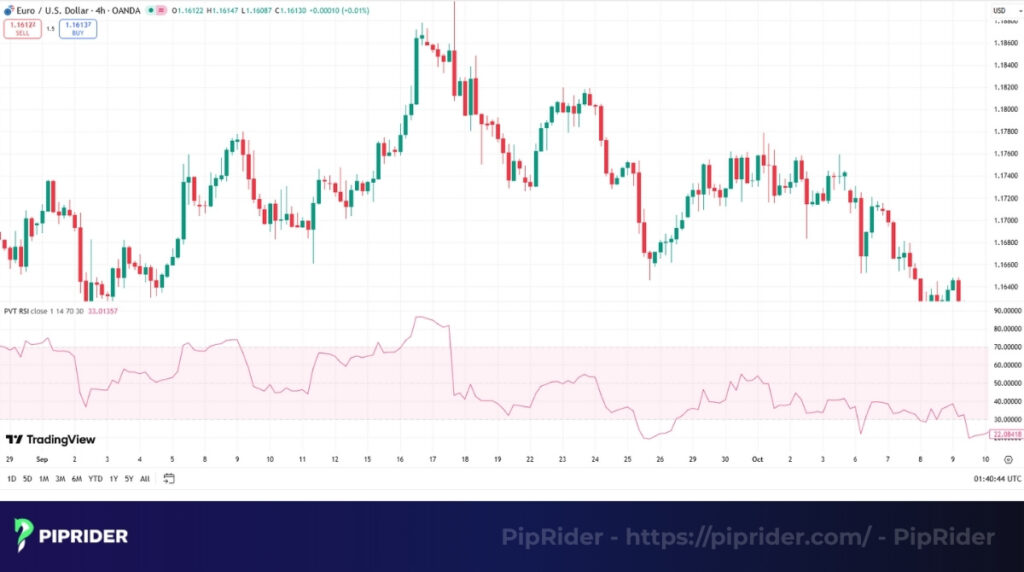
- Combining with Relative Strength Index (RSI): Confirm reversals by combining RSI overbought/oversold readings with a PVT divergence. RSI reading above 70 paired with a bearish PVT divergence creates a high-probability sell signal.
- Combining with MACD: Strengthen entry signals by requiring alignment. A bullish MACD crossover becomes a much stronger buy signal when the PVT is also in a clear uptrend. This alignment confirms that both price momentum and the underlying volume flow agree, increasing the probability of a successful trade.
- Combining with Moving Averages (MAs): Filter for trend direction by using an MA (e.g., 50 EMA) to define the primary trend. Only take buy signals from the PVT when the price is above the MA to avoid risky counter-trend trades.
- Combining with Volume Profile: Pinpoint key levels by using this indicator to find high-volume support/resistance zones. A price bounce from a major support level is confirmed if the PVT also begins to rise, indicating real money is entering the market.
9. Limitations of the Price Volume Trend Indicator
No indicator is perfect, and the PVT is no exception. Understanding its weaknesses is crucial for avoiding common traps and using it effectively.
- Lagging nature: The PVT is a lagging indicator because it is based on past data. It will always confirm a move after the price has already started to change, which can lead to delayed signals.
- Dependence on reliable volume data: The indicator is entirely dependent on accurate volume data. This makes it highly effective for stocks or futures but unreliable for decentralized markets like spot Forex, where true trading volume is not available.
- Susceptibility to noise on lower timeframes: On very short timeframes (e.g., 1-minute or 5-minute charts), erratic volume spikes can create significant noise and false signals. The indicator is generally more reliable on higher timeframes (4-hour, daily).
- Requirement for confirmation: Relying solely on the PVT is a risky strategy. Its signals, especially divergences, should always be confirmed with other forms of analysis, like price action, the RSI, or Bollinger Bands.
10. Practical Example and Chart Setup
Let’s combine these concepts into a complete trading setup. This example uses a Daily (D1) chart, a 20-period EMA to define the trend, and a PVT divergence to spot the reversal. The goal is to use the indicator for an early warning and the EMA for a precise entry trigger, creating a high-probability trade.
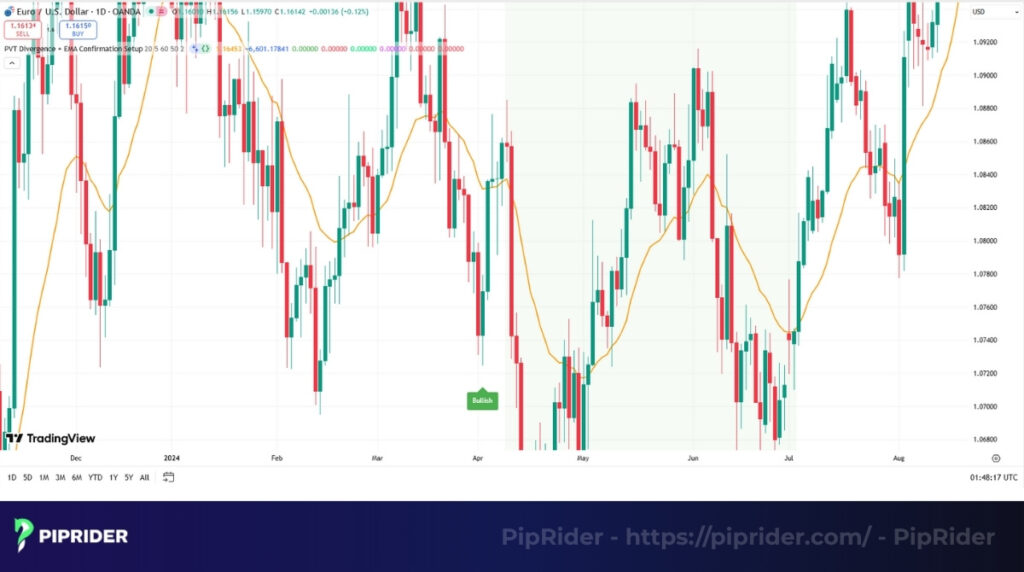
- The Signal: First, we identify a bullish divergence where the price makes a new low but the PVT forms a higher low. This is our signal that selling pressure is weakening and the downtrend may be ending.
- Entry: After spotting the divergence, wait for price confirmation. The entry is triggered only when a candle crosses and closes decisively above the 20 EMA, showing that momentum has officially shifted in your favor.
- Stop Loss: A logical stop loss should be placed just below the recent swing low that formed the divergence. This ensures that your trade is invalidated and you exit with a small loss if the reversal fails.
- Take Profit: An initial profit target can be set at a previous, significant resistance level where sellers previously showed strength. For stronger trends, a trader might choose to trail the stop loss to capture a larger portion of the move.
11. Frequently asked questions about Price Volume Trend Indicator
12. The Bottom Line
The Price Volume Trend indicator (PVT) is a powerful tool that goes beyond simple price analysis. By integrating volume with the magnitude of price changes, it helps traders authenticate trends and see the real conviction in the market. It is highly effective when used to confirm breakouts, spot divergences, and gauge the true strength behind a price move.
When combined with indicators like the RSI and moving averages, the PVT transforms into a comprehensive money-flow filter, allowing for a more sophisticated and reliable trading approach. To continue building your analytical edge, follow our Broker Reviews section at Piprider to discover and master more essential Forex Indicators.


